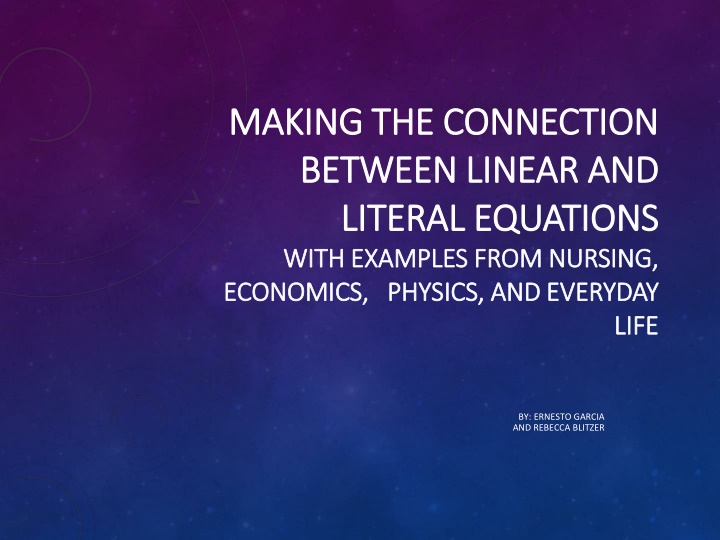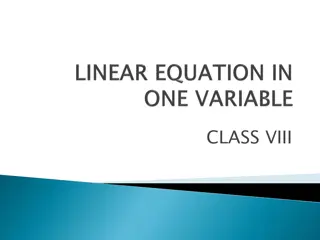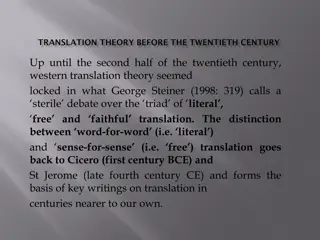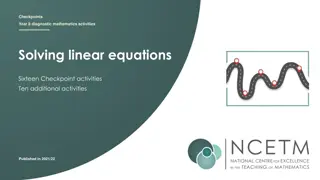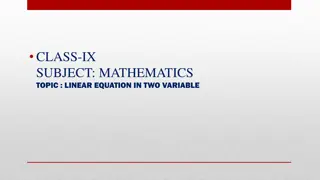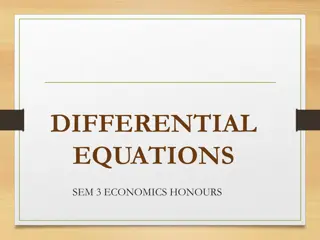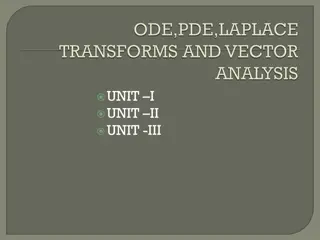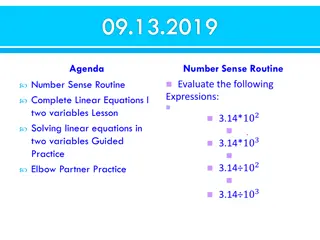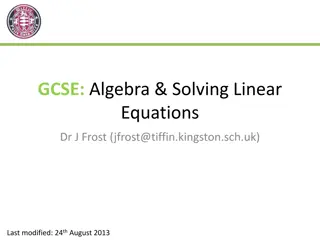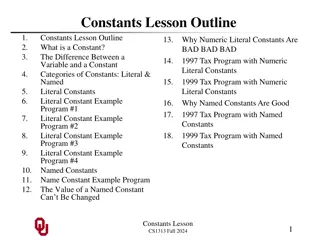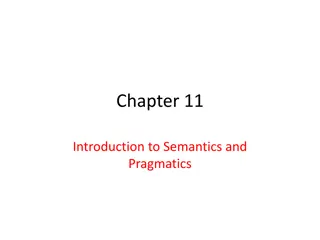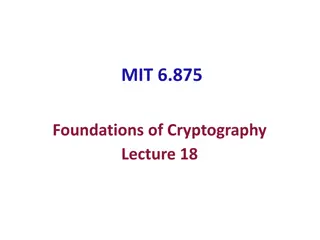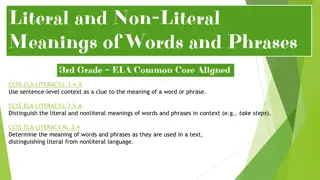Connecting Linear and Literal Equations in Various Fields
Delve into the connection between linear and literal equations through examples from nursing, economics, physics, and everyday life. Understand how to solve equations and navigate literal equations with known values, along with the basics of equations.
Download Presentation

Please find below an Image/Link to download the presentation.
The content on the website is provided AS IS for your information and personal use only. It may not be sold, licensed, or shared on other websites without obtaining consent from the author.If you encounter any issues during the download, it is possible that the publisher has removed the file from their server.
You are allowed to download the files provided on this website for personal or commercial use, subject to the condition that they are used lawfully. All files are the property of their respective owners.
The content on the website is provided AS IS for your information and personal use only. It may not be sold, licensed, or shared on other websites without obtaining consent from the author.
E N D
Presentation Transcript
MAKING THE CONNECTION MAKING THE CONNECTION BETWEEN LINEAR AND BETWEEN LINEAR AND LITERAL EQUATIONS LITERAL EQUATIONS WITH EXAMPLES FROM NURSING, WITH EXAMPLES FROM NURSING, ECONOMICS, PHYSICS, AND EVERYDAY ECONOMICS, PHYSICS, AND EVERYDAY LIFE LIFE BY: ERNESTO GARCIA AND REBECCA BLITZER
WHAT IS AN EQUATION? An equation is a statement saying that the two mathematical expressions on either side of the equal sign (denoted by = ) are equivalent. Examples: ? + 11 = 18 3 =?+4 9 ? 3+ 4 = 1
HOW DO WE SOLVE THE PREVIOUS EXAMPLES? ? + 11 = 18 ? 3+ 4 = 1 3+ 4 4 = 1 4 3= 3 3 3 = 3 3 ? = 9 ? + 11 11 = 18 11 ? ? = 7 ? 3 =?+4 ? 9 3 9 =?+4 9 9 27 = ? + 4 27 4 = ? + 4 4 23 = ?
WHAT IS A LITERAL EQUATION? A literal equation is an equation where the variables represent known values. Literal equations make life so much easier. The next slide shows some examples of literal equations.
Examples: ? = ??? (Simple interest) ? =? ? (Ohm s law) ? = ?? (Area of a rectangle) ? = ?? (Second Law of Motion) ? = ??2 (Mass/Energy Equivalence) ? =9 5? + 32 (Fahrenheit/Celsius Equation) 2 ????????? +???????? ??? = (MAP=mean arterial pressure) 3 ? = 0.041 0.018? 2.69 (Female vitals) ? =??1?2 (Law of Universal Gravitation) ?2
In order to solve these one must: be able to algebraically manipulate the equations that contain letters and variables. realize they are not much different from solving plain old linear equations.
HOW DO WE SOLVE OUR PREVIOUS EXAMPLES IF THEY ARE LITERAL EQUATIONS? COMPARE LEFT AND RIGHT. ? + ? = 18 ? + ? ? = 18 ? ? = 18 ? ? + 11 = 18 ? + 11 11 = 18 11 ? = 7 3 =? + ? 3 =? + 4 ? 9 3 ? =? + ? 3 9 =? + 4 ? 9 ? 9 3? ? = ? ? 3? ? = ? 3? = ? + ? 27 4 = ? + 4 4 23 = ? 27 = ? + 4
? ?+ ? = 1 ?+ ? ? = 1 ? ?= 1 ? ? ? = 1 ? ? ? = 1 ? ? ? 3+ 4 = 1 3+ 4 4 = 1 4 3= 3 3 3 = 3 3 ? = 9 ? ? ? ? ? ? Notice how the skills required to solve the equation on the right are the same as the ones needed to solve the equation on the left.
USING LITERAL EQUATIONS USING LITERAL EQUATIONS IN EVERYDAY LIFE IN EVERYDAY LIFE The equation on the left shows the equation of a line where b is the y- intercept, and x and y represent the values in the ordered pair. The equation on the right is a total-cost formula for factory machine service where T is the total cost, F is a fixed fee, Q is the amount of a service given, and V is the amount of times this service is provided. ? = 3? + ? ? = ? + ?? Solve for ? given the point 2,10 . Solve for ? when ? = 78, Q = 10, ? = 4. 78 = ? + 10(4) (plug in given values) 78 = ? + 40 (4 10) 38 = ?(subtract 40 from both sides) 10 = 3 2 + ? (plug in (2,10) 10 = 6 + ? (3 2=6) 4 = ? (subtract 6 from both sides) With practice, you should be able to translate your algebra skills to equations that have more letters and variables than your standard linear equation.
MANIPULATING LITERAL EQUATIONS MANIPULATING LITERAL EQUATIONS Sometimes, we need to manipulate literal equations to express the relationship between quantities in a different way.
Question 1: Solve ? =9 5? + 32 for ?. Solution: This equation is used to convert between Fahrenheit and Celsius. Here we have the equation set up to convert from Celsius into Fahrenheit. Solving for ? will flip that to converting Fahrenheit into Celsius. ? =9 5? + 32 ? 32 =9 5? + 32 32 ? 32 =9 5? 5 9 ? 32 =5 5 9 ? 32 = ? 9 9 5?
Question 2: Solve 3 + ? = 5 ? for . Solution: 3 + ? 3 = 5 ? 3 ? = 2 ? ? + ? = 2 ? + ? ? + ? = 2 ? + ? 1 2= 2 1 2 1 2? + ? =
Question 3: Suppose you need $? for an upcoming vacation. Your savings account pays $?? if you leave $? in your account for 1 year (? is called the principal and ? is called the nominal interest rate). Hence if you put $? in the bank today, your account will have $? + $?? next year. This so happens to be when you need the money for your vacation. How much money must you put in the bank today in order to ensure you have $??
Solution: What we are looking for is what our initial deposit should be. We know $?and ? (even if they are not given here, those are numbers that can be easily looked up). We want a general equation so our initial deposit can be calculated regardless of those two numbers actual quantities. We know we need the following relationship to hold ? = ? + ?? (this is called compounding) So what is $? (the initial deposit or principal)? ? = ? + ?? ? = ? 1 + ? 1 1 ? 1 + ?= ? 1 + ? ? 1+?= ? (this is called discounting) 1 + ?
Question 4: The height, h, of a woman can be approximated by using the formula h= 3.9r +29. In this formula, r is the length of the radius bone in the forearm and must be measured in inches. Find the approximate height of a woman whose radius bone is r = 10 inches. Express your answer in terms of feet and inches.
To figure out the approximate height, substitute 10 for r and evaluate the resulting expression. h= 3.9(10) +29 = 68 inches To write 68 inches in terms of feet and inches, divide 68 by 12 and express the answer as an unreduced mixed number. 68 12= 5 (8/12) Therefore, 68 inches is equal to 5 ft 8 in.
Question 5: A pharmacist needs to fill an order for a 3% lidocaine topical cream. However, only 2% and 5% concentrations are in stock. How much of the 5% concentration should be mixed with 50 g of the 2% concentration to get a 3% concentration? Check your answer. Solution: We are going to let x= the amount of 5% concentration. The 5% concentration is mixed with the 2% concentration get the 3% concentration, the amount of 3% will be x+50. In other words, the basic equation for this problem is (amount of 5%) + (amount of 2%) = (amount of 3%) (x) + (50) = (x+50) Including the concentrations, the above equation becomes: 5%(x) + 2%(50) = 3%(x+50) Rewriting the percent's as decimals: 0.05x + 0.02(50) = 0.03 (x+50) Simplifying: 0.05x + 1 = 0.03x + 1.5
CONTINUATION Solving for x: 0.05x + 1 = 0.03x + 1.5 Subtracting 0.03x from both sides: 0.02x + 1 = 1.5 Subtracting 1 from both sides: 0.02x = 0.5 Dividing both sides by 0.02 results in: x= 25 Therefore, the pharmacist must take 25 g of the 5% lidocaine concentration and add it to 50g of the 2% concentration, yielding 75g of a 3% lidocaine blend.
Check The equation for this problem is 5%(x) + 2%(50) = 3% (x + 50). 5% (25) + 2% (50) = 3% (25 + 50) Substitute x = 25 0.05 (25) + 0.02 (50) = 0.03 (25 + 50) Write percents as decimals 1.25 + 1 = 0.03 (75) Simplify 2.25 = 2.25 Checks
As you have now seen, literal equations do not require a different skill set. One must simply apply the skills he or she already has from learning linear equations to literal equations. The exercises in the worksheet will help you apply the skills you already possess in linear equations to literal equations.
